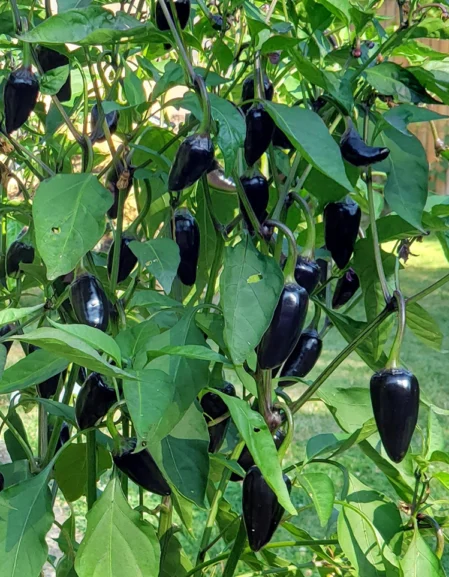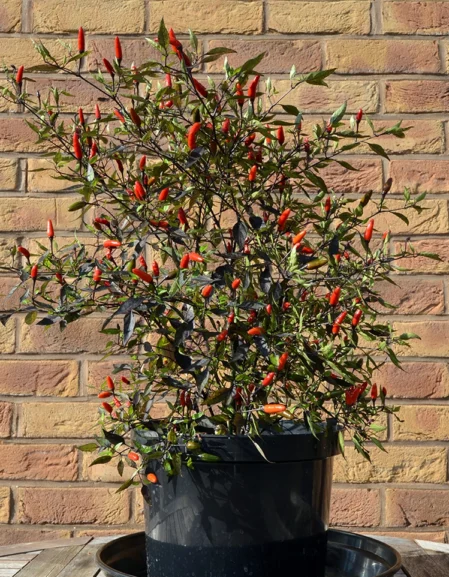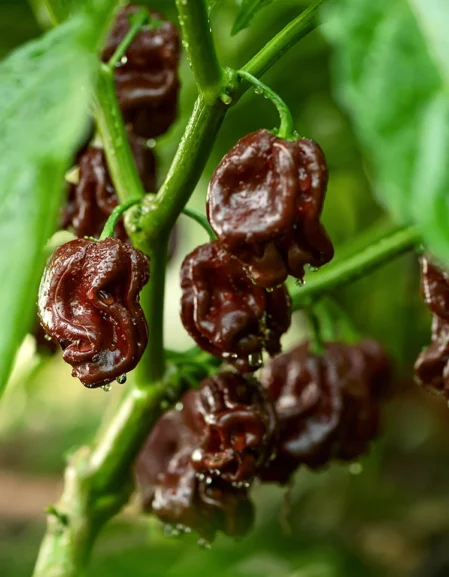Jump to: Chilli Types | Seed Starting | Growing Conditions | Germination & Soil | Potting On | Alternative Growing | Pollination | Watering | Pest & Diseases | Acclimatising Plants | Overwintering | Harvesting | Tips
This comprehensive guide covers everything you need to know to successfully grow chilli peppers in a UK greenhouse. Key topics include:
- Selecting the right chilli varieties based on heat level, plant size, and growing requirements
- Seed starting options, including using a propagation mat or sunny windowsill
- Maintaining ideal growing conditions like temperature, humidity, and lighting
- Preparing the soil and potting mixes for optimal plant health
- Tips for container growing and graduated transplanting
- Advanced automated watering systems to simplify irrigation
- Effective pest and disease management strategies
- Properly acclimating plants when transitioning outdoors
- Overwintering perennial chilli varieties for multi-year harvests
- Preserving your chilli pepper harvest through drying, pickling, and freezing
- UK-specific considerations like supplemental lighting and weather protection
With this detailed guidance, you’ll be able to cultivate an abundant, flavourful crop of homegrown chilli peppers in your UK greenhouse.
Selecting the Right Chilli Varieties
When choosing chilli varieties for your UK greenhouse, consider factors like heat level, plant size, and growing requirements. Popular Capsicum annuum varieties include jalapeño, cayenne, and bell peppers. Capsicum chinense types like habanero and ghost pepper offer extreme heat. Capsicum frutescens features the tabasco pepper, while Capsicum baccatum includes the fruity aji amarillo. For cooler climates, Capsicum pubescens varieties like rocoto are well-suited.
Understanding the Scoville Heat Unit (SHU) scale is crucial when selecting chillies. This measures pungency, with bell peppers at 0 SHU, jalapeños around 2,500-8,000 SHU, habaneros 100,000-350,000 SHU, and the ex-record-holding Carolina Reaper exceeding 1.5 million SHU. Choose varieties matching your preferred spice level.
Seed Starting Options
While using a heated propagation mat is ideal for maintaining the 27-32°C soil temperature required for optimal germination, you can also start chilli seeds on a sunny, south-facing windowsill if a mat isn’t available. Just be sure to monitor soil moisture carefully and provide supplemental lighting as needed. It’s best to start your chilli pepper seed off in late winter especially slow growing types like Capsicum chinense and most super hots as these require a very long growing season!
-
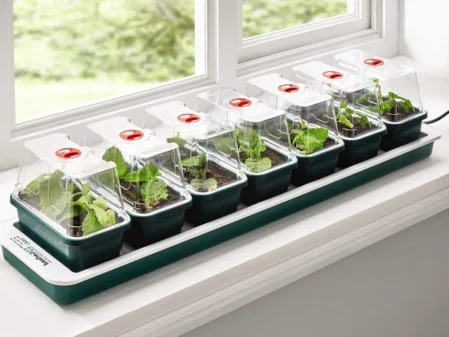 Super 7 Electric Windowsill Propagator£44.99
Super 7 Electric Windowsill Propagator£44.99 -
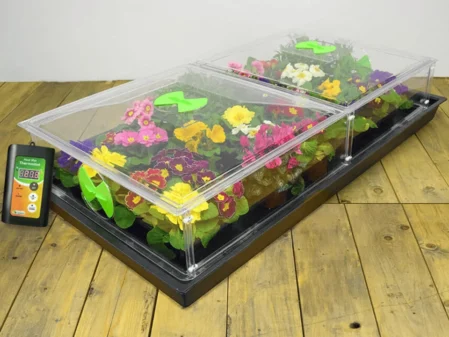 Large Vitopod Electric Propagator£199.99 – £249.98
Large Vitopod Electric Propagator£199.99 – £249.98
Ideal Growing Conditions
Chilli peppers thrive in warm, humid environments. Aim to maintain daytime temperatures between 18-25°C and night time lows of 15-17°C. Relative humidity levels should be 60-70% – use automated misting systems or strategic ventilation to achieve this.
Providing ample light is crucial. Chillies require at least 6 hours of direct sunlight per day, so site your greenhouse accordingly or supplement with high-output LED grow lights, especially during overcast weather and for seed starting.
Germination and Soil Preparation
For optimal germination, chilli seeds need consistently warm soil temperatures between 27-32°C. Use a heated propagation mat to maintain this range. Sow the seeds 0.5-1 cm deep in a sterile, well-draining seed starting mix, keeping the soil evenly moist but not waterlogged.
When preparing potting mixes, blend high-quality compost with perlite to create a light, airy medium that retains moisture without becoming dense or sodden. Amend with a balanced, slow-release organic fertiliser to nourish plants throughout the growing season.
Potting and Container Growing
Chilli plants thrive when grown in containers, as this allows you to control soil quality and moisture levels. Start seedlings in small pots or germination trays. Once they develop true leaves and outgrow the current tray or pot, transplant them into larger pots.
As the plants mature, gradually upsize the pots, moving to 1L and eventually 5L or larger containers. This staged repotting minimises transplant shock and encourages extensive, healthy root growth. Use premium potting mix and ensure excellent drainage.
Consistent, even soil moisture is crucial for chilli plants. Consider investing in automated watering systems designed specifically for container-grown chillies.
Watering
Regularly check the soil moisture by sticking your finger into the potting mix. Water deeply when the top inch feels dry, taking care not to waterlog the roots.
Advanced Watering Systems
- ChilliGrow System: Features a reservoir that maintains ideal moisture levels without risk of waterlogging.
- Quadgrow System: A self-watering setup that uses wicking action to keep the root zone hydrated.
- Autopots: Provide a continuous water supply, reducing labour and optimising efficiency.
These specialised systems take the guesswork out of watering, promoting optimal growth and abundant fruit production.
Pollination in Greenhouses
Since natural pollinators like bees are less frequent in greenhouses, you may need to hand-pollinate chilli flowers. Use a small, soft paintbrush to gently transfer pollen from the male stamens to the female stigmas, encouraging fruit set.
Pest and Disease Management
Common greenhouse pests that may target your chilli plants include aphids, slugs, snails, spider mites, and whiteflies. Use organic insecticidal soaps, neem oil, or introduce beneficial predators like ladybugs and lacewings to control infestations. Copper barriers and diatomaceous earth can deter slugs and snails.
For disease prevention, maintain good air circulation, use disease-resistant seed varieties, and avoid overhead watering, which can spread fungal spores. Watch for issues like powdery mildew, bacterial spot, and blossom end rot, treating promptly with organic fungicides if needed.
Acclimatising Plants Outdoors
When transitioning chilli plants from the greenhouse to the outdoor garden, take care to avoid shocking them with sudden changes in temperature, light, and wind exposure. Wait until all risk of frost has passed before moving plants outside, typically in late spring or early summer.
Gradually acclimate them by increasing their daily outdoor time over 7-10 days, starting with just a few hours and working up to full-day exposure. This incremental process allows the plants to toughen up and adjust to the new conditions.
Overwintering Chilli Peppers
Some chilli pepper varieties, particularly perennials like the rocoto (Capsicum pubescens), can be overwintered indoors with proper care. This allows you to enjoy the plant for multiple seasons. Reduce watering, provide bright light, and maintain temperatures around 15-18°C.
Harvesting Chilli Peppers
Depending on the variety, chilli peppers are typically ready to harvest 90-150 days after sowing. Look for visual cues like the desired colour (deep green for jalapeños, orange or red for habaneros) and firm, glossy skin.
Frequent harvesting, even removing individual peppers as they mature, encourages the plant to continue producing new fruit throughout the season. Snip the chilli’s from the plant using sharp, clean scissors, leaving a short stem attached. Avoid pulling or twisting, which can damage the plant. Alternatively you can allow all your chilli’s to ripen on the plant and harvest all at once at the end of the season.
Preserving Your Harvest
To enjoy your chilli peppers long after the growing season, consider drying, pickling, or freezing them. Dried chillies make excellent spice blends, while pickled or frozen peppers can add heat and flavour to countless dishes.
Tips
Remember that the UK’s shorter daylight hours, especially in winter, may require supplemental grow lighting to ensure your chilli plants receive enough light.
Perfecting Chilli Growing in a UK Greenhouse
By selecting the right chilli cultivars, providing ideal growing conditions, and managing pests and diseases, you can grow an abundant chillies in your greenhouse. With the guidance outlined in this comprehensive guide, you’ll be well on your way to spicing up your culinary adventures.

